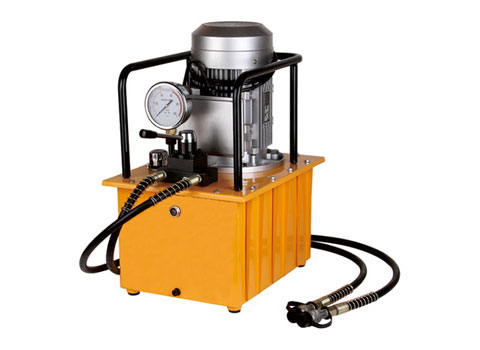Electric Hydraulic Pump Troubleshooting
The hydraulic pump output flow is insufficient or does not output oil
Insufficient suction. Excessive resistance on suction line or insufficient charge. Such as the pump speed is too large, the liquid level in the oil tank is too low, the oil inlet pipe leaks, the oil filter is blocked, etc.
Excessive leakage. The gap of the pump is too large, which is caused by poor sealing. For example, the oil distribution plate is scratched by metal fragments, iron filings, etc., and the end face leaks oil, the sealing surface of the one-way valve in the variable mechanism is not well matched, and the bearing surface of the pump body and the oil distribution plate has blisters or grinding marks. Solution: Identify the damaged part of the pump by checking the foreign matter mixed in the hydraulic oil in the pump body.
The inclination angle of the swash plate is too small, and the displacement of the pump is small. Solution: adjust the variable piston and increase the inclination of the swash plate.

The oil discharge is not zero at the neutral position
When the inclination of the swash plate of the variable axial piston pump is zero, it is called the neutral position, and the output flow of the pump should be zero at this time. But sometimes there is a phenomenon that the median deviates from the midpoint of the adjustment mechanism, and there is still flow output at the midpoint. The reason is that the position of the controller is deviated, loose or damaged, and it needs to be re-zeroed, tightened or replaced. Insufficient angular maintenance of the pump and wear of the tilt trunnion can also cause this phenomenon.
Fluctuation of output flow
Output flow fluctuations are related to many factors. The variable pump can be considered to be caused by the poor control of the variable mechanism, such as foreign matter entering the variable mechanism, and scratches, wear marks, scars, etc. are drawn on the control piston, resulting in unstable movement of the control piston. Due to insufficient amplifier energy or damaged parts, the damper of the spring-containing control piston has poor performance, which can cause the control piston to move erratically. Unstable flow is often accompanied by pressure fluctuations. Such failures generally require dismantling the hydraulic pump, replacing damaged parts, increasing damping, increasing spring stiffness and control pressure.
Abnormal output pressure
Output pressure too low
When the hydraulic electric pump is in the self-priming state, if the oil inlet pipeline leaks or there is a large leak in the hydraulic cylinder, check valve, reversing valve, etc. in the system, the pressure will not rise. This requires finding the air leak, tightening and replacing the seal, and the pressure can be increased. The overflow valve is faulty or the adjustment pressure is low, and the system pressure cannot go up. The pressure should be re-adjusted or the overflow valve should be repaired. If the cylinder block of the hydraulic pump deviates from the valve plate and causes a large amount of leakage, the cylinder block may be broken in severe cases, and the mating surface should be reground or the hydraulic pump should be replaced.
The output pressure is too high
If the circuit load continues to rise, the pressure of the pump also continues to rise, which is normal. If the load is constant and the pressure of the pump exceeds the pressure value required by the load, the hydraulic components other than the pump should be checked, such as directional valve, pressure valve, transmission device and oil return pipeline. If the maximum pressure is too high, the relief valve should be adjusted.
Vibration and noise
Mechanical vibration and noise
If the pump shaft and the motor shaft are not concentric or top dead, the bearings and couplings of the rotating shaft are damaged, the elastic pad is damaged and the assembly bolts are loose, all of which will generate noise. For pumps that run at high speed or transmit large energy, check regularly and record the amplitude, frequency and noise of each component. If the rotational frequency of the pump is the same as the natural frequency of the pressure valve, resonance will be caused, and the rotational speed of the pump can be changed to eliminate the resonance.
The noise generated by the liquid flow in the pipeline
The oil inlet pipe is too thin, the flow capacity of the oil inlet oil filter is too small or blocked, the oil inlet pipe sucks air, the oil gap is too high, the oil level is too low, the oil absorption is insufficient, and there is liquid hammer in the high-pressure pipeline, etc., noise will be generated. Therefore, the fuel tank must be properly designed, and the oil filter, fuel pipe and directional valve must be selected correctly.
Hydraulic pump overheating
There are two reasons for the excessive heating of the hydraulic pump. One is the heat generated by mechanical friction. Since the moving surfaces are in a state of dry or semi-dry friction, the moving parts rub against each other to generate heat. The second is heat generation by liquid friction. The high-pressure oil leaks into the low-pressure chamber through various gaps, and a large amount of hydraulic energy loss is converted into heat energy. Therefore, the correct selection of the gap between the moving parts, the volume of the fuel tank and the cooler can prevent the excessive heating of the pump and the excessively high oil temperature. In addition, the blockage of the oil return filter will cause the oil return back pressure to be too high, which will also cause the oil temperature to be too high and the pump body to overheat.

